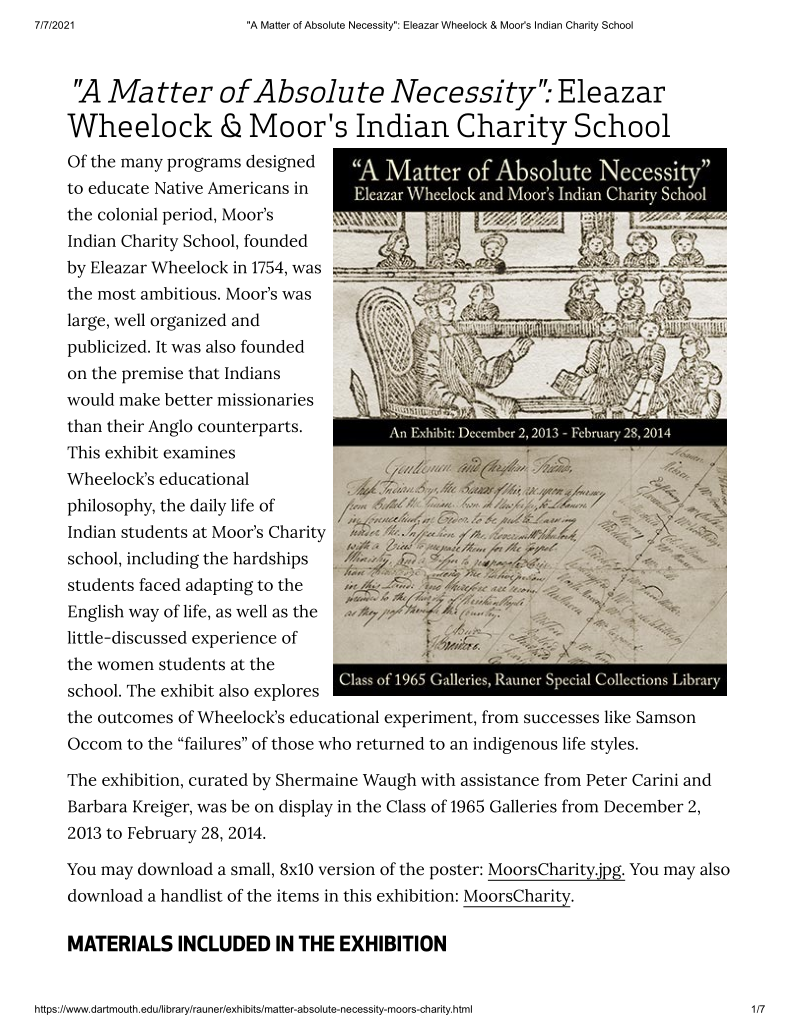An exhibit summarized by DCL recounts the history of Moor's Charity school.
- Type
- Website
- Source
- Dartmouth College Library Non-LDS
- Hearsay
- Secondary
- Reference
Dartmouth College Library, "'A Matter of Absolute Necessity': Eleazar Wheelock & Moor's Indian Charity School", 2013-2014, accessed June 18, 2021
- Scribe/Publisher
- Dartmouth College Library
- Audience
- General Public
- Transcription
"A Matter of Absolute Necessity": Eleazar Wheelock & Moor's Indian Charity School
Of the many programs designed to educate Native Americans in the colonial period, Moor’s Indian Charity School, founded by Eleazar Wheelock in 1754, was the most ambitious. Moor’s was well organized, large, and well-publicized. It was also founded on the premise Indians would make better missionaries than their Anglo counterparts in part because Indian missionaries could be supported for half the cost of English missionaries; they spoke the Indian languages; and they were accustomed to Indian lifestyles.
Moor’s grew out of Wheelock’s experience tutoring his first student, a Mohegan named Samson Occom, but Wheelock largely felt the plan was divinely inspired. Located in Lebanon Connecticut the school was named for its chief benefactor, Joshua Moor, who donated a house and two acres of land. Like other schools of its kind the Indian boys who attended the Charity school were separated from their native culture. Unlike other schools they were given a classical education that included, in addition to bible studies the study of Latin and Greek. Indian girls also received schooling, but attended academic classes only one day a week. Their other training focused the household arts they would need to support the Christian brethren.
By 1768 about 50 students had studied at the school and 15 returned to their homes as missionaries, schoolmasters, or assistants to non-Indian Ministers. When Eleazar Wheelock realized that his plan of sending missionaries to Indian homelands to educate and convert Indians was not working as he desired, he began to move in a new directions. In 1769, he received a charter for a new school, which would be named for William, second Earl of Dartmouth. Wheelock would later be appointed Dartmouth College’s first president. Moor’s, relocated to Hanover New Hampshire, continued on as a sort of feeder school for Dartmouth, educating both Indian and English students who were not prepared to take on College level studies.
1. In this 1756 letter to Reverend Whitefield, Eleazar Wheelock describes his disapproval over the state of neglect that has led to what he describes as “the piteous state of the Indian Natives of this Continent. ”Wheelock believes the only solution to the “problem of the Indians” is to educate and spread the Gospel among them, which would hopefully keep them from a life of “hunting and rambling” (Mar. 1, Lebanon). MSS D.C. Hist. 756201 (MS-1310, Box 3)
2. This small notebook consists of a list of students in attendance at Wheelock’s Charity School along with their dates of entrance (1757). MSS D.C. Hist. 757900.3
3. The original Passport for Indian Youths on their journey from "Bethel," N.J. to Eleazar Wheelock's Charity School. The 'passport' combines, on a single sheet of paper, a letter and diagonally placed travel directions. The left side of the itinerary has twenty-seven place names, beginning with Bethel at the bottom of the page and Lebanon at the top. Each place name is complemented on the right side by a name of reference, where the boys could ask for assistance, food, and shelter (1754). MSS D.C. Hist. 754900 (MS-1310, Box 3). Manuscript donated by Rev. Henry Goodwin Smith.
4. Towards the end of this letter from Wheelock to Sir Wm. Johnson Wheelock outlines his plan for Indian girls to be instructed “in all ye arts of good Housewivery, Tending a Da[i]ry, Spinning, the use of their Needle” as well as reading and writing (Dec. 11, 1761. Lebanon). MSS D.C. Hist. 761661 (MS-1310, Box 5)
5. This letter from Eleazar Wheelock to Governor Wentworth explains the Charity School’s goals, and provides an account of its achievements. Wheelock stresses his goal to “cure the natives….of their savage temper, deliver them from their low, sordid and brutish manner,” and make them “good wholesome members of society, and obedient subjects to the king of Zion.” The letter also mentions of the importance of the Indian girls’ instruction in being good housewives (Sept. 21, 1762, Lebanon). MSS D.C. Hist. 762521.1 (MS-1310, Box 6)
6. John Daniel, the father of one of the Indian boys attending Moor’s School Writes to Wheelock objecting to Wheelock’s focus on husbandry and having his son used for two years as a workhand on the farm while he is attending school. Daniel closes by withdraw his son from the school. (Nov. 30, 1767. Charlestown) MSS D.C. Hist 767630.3 (MS-1310, Box 17)
7. A letter from John Smith detailing his visit to the Charity School and a day in the life of the Indian students, from the ringing of the schoolhouse bell to singing psalms and reading and reciting verses in English. (Boston, May 18th 1764) MSS D.C. Hist 764318.2 (MS-1310, Box 8)
8. A writing sample from one of the students, Hezekiah Calvin, aged 11, a Delaware Indian. The sample is a copied Latin motto, and includes a note by Eleazar Wheelock about the writer on the back (Lebanon, Nov. 19, 1759.) MSS D.C. Hist 759619 (MS-1310, Box 4)
9. Letter from Sarah Bingham to David McClure mentions the “ignorant” and “savage” behavior of the women at Wheelock’s Charity School along with disciplinary problems surrounding excess consumption of liquor. (August 1, 1787) MSS D.C. Hist. 787451 (MS-1311, Box 2)
- Citations in Mormonr Qnas
The B. H. Roberts Foundation is not owned by, operated by, or affiliated with the Church of Jesus Christ of Latter-day Saints.

